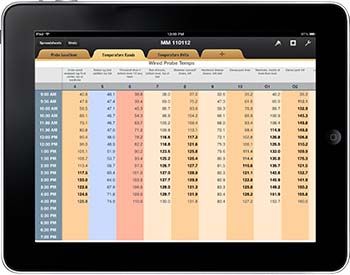Managing Airflow and Temperatures for a Successful Heat Treatment
by Tom Costello, Technical Director
March 26, 2018
Once the heaters are functioning, and the heat is flowing through the job site, double check all exits and windows to make sure they are air-tight. Right after start-up, go through and quickly take air temperature readings with a hand-held thermometer to look for areas that are not disbursing heat as well as they should. Remedy too hot locations, too cold situations, and stagnant areas immediately.
Assessing Airflow
 Assessing airflow can be difficult because air is invisible. Furnishings and building compartmentalization require technicians to review airflow throughout the job site—and each room needs its own adequate airflow. There is a very valuable, low-tech tool for measuring airflow both inside structures and around the outside: toilet paper.
Assessing airflow can be difficult because air is invisible. Furnishings and building compartmentalization require technicians to review airflow throughout the job site—and each room needs its own adequate airflow. There is a very valuable, low-tech tool for measuring airflow both inside structures and around the outside: toilet paper.
Take a one- to two-foot-long piece of toilet paper and hold it in your hand and watch it move in the air. Stand in a doorway and watch the airflow coming into or leaving the room. Stand by a window, hold it and watch the airflow entering or leaving the room through the window. Use it in the interior of rooms around closets and cabinets. Tape pieces of toilet paper to key obstructions in the job site: behind bookshelves, on table legs or boxes, in closets, next to furniture that has been pulled away from walls. The toilet paper taped throughout the jobsite can help give a quick overview of the entire treatment area and let you review how changes in one part affect the others.
When utilizing electric-powered heaters for the treatment of bed bugs it is not necessary to constantly examine the interior of the treatment area. Treatment temperatures are lower than when treating with direct-fired heaters—and temperature changes happen at a slower rate. If the fans have been properly placed, the air flow should achieve an eradication. Sometimes it is necessary to relocate heater placement or fan placement if the temperature monitoring shows below-lethal levels in certain locations of the treatment area.
Walk around the treatment area, using a strip of toilet paper to follow the air flow. Reposition furniture, fans, or heaters to direct air to cooler areas and away from sensitive items.
 It is recommended that temperature readings from each probe location be taken every fifteen to thirty minutes, but no less than hourly. Record the temperatures on your heat log. Graph this information with time and temperature. Reviewing temperatures and analyzing how rapidly these temperatures increase will give a good idea of how the job is progressing. Seeing the difference in temperature rises between different areas will also give an idea of whether there are areas that are not heating fast enough and need to have additional heat applied to them. This information is important in regard to evaluating the GreenTech Heat Treatment and helping to best analyze how to finish the job as soon as possible.
It is recommended that temperature readings from each probe location be taken every fifteen to thirty minutes, but no less than hourly. Record the temperatures on your heat log. Graph this information with time and temperature. Reviewing temperatures and analyzing how rapidly these temperatures increase will give a good idea of how the job is progressing. Seeing the difference in temperature rises between different areas will also give an idea of whether there are areas that are not heating fast enough and need to have additional heat applied to them. This information is important in regard to evaluating the GreenTech Heat Treatment and helping to best analyze how to finish the job as soon as possible.
Finding cold spots inside with a hand-held laser temp sensor in the initial stages will allow the technician to make the appropriate adjustments to overcome those low air temperatures and create treatment temperatures for those cold areas to accomplish the job faster. It is important to take air temperature readings in the areas of heat sinks to make sure lethal temperatures are reached inside those areas. These air temperature samples are very valuable in establishing whether the treatment is effective. The air temperature samples can lead to a change in the way the job is set up to facilitate a more rapid treatment.
It is necessary to constantly evaluate both the temperature and airflow in the treatment area. Utilizing a short piece of toilet paper, the airflow through a treatment area can be determined. The air current will move the paper and give an indication of strong or weak air movement. That, in conjunction with the hand-held laser temp sensor, will give vital information on the conditions inside the treatment area.
 Ideally, all probe areas would come up to lethal temperature at the same time. Unfortunately, that kind of perfection is hard to achieve, but the technician needs to look at trying to achieve it as much as possible to expedite the job and minimize bed bug migration. One slow-to-heat area will dictate how long the job is going to take to accomplish. It does not matter that five, six or all of the rest of the probe locations came up to temperature very rapidly. Every probe location must be up to temperature before the job is finished. Therefore, it is prudent, in the beginning, to find these cooler areas and give them special attention; even if that means reducing heat to some of the areas that are rising in temperature more rapidly. Worry about the coldest, hardest-to-heat locations in the job from the very beginning to reduce the treatment times as much as possible.
Ideally, all probe areas would come up to lethal temperature at the same time. Unfortunately, that kind of perfection is hard to achieve, but the technician needs to look at trying to achieve it as much as possible to expedite the job and minimize bed bug migration. One slow-to-heat area will dictate how long the job is going to take to accomplish. It does not matter that five, six or all of the rest of the probe locations came up to temperature very rapidly. Every probe location must be up to temperature before the job is finished. Therefore, it is prudent, in the beginning, to find these cooler areas and give them special attention; even if that means reducing heat to some of the areas that are rising in temperature more rapidly. Worry about the coldest, hardest-to-heat locations in the job from the very beginning to reduce the treatment times as much as possible.



